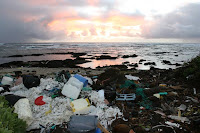Check it out: 35% of fishes collected in the north Pacific Ocean had plastic in their stomachs, according to a group of Southern California researchers. The Algalita Marine Research Foundation and the Southern California Coastal Water Research Project were looking at the effects of plastic litter floating in the ocean on marine life.
The researchers traveled 1,000 miles off the coast of California, in an area called the Great Pacific Garbage Patch, to collect lanternfishes, small deep sea dwellers that come to the surface after dark to dine on plankton. Amid the floating bottles, plastic bags and nurdles (tapioca-size plastic pellets), lantern fish and other marine life swim and search for food. Sometimes they find plankton, sometimes plastic.
The collected fish had, on average, ingested at least two pieces of plastic; however, researchers found as many as 83 pieces of plastic in one fish. Concerns are that the plastics travel up the food chain and will eventually be ingested by humans.
Although plastics are broken down to a degree by crashing waves, scientists still do not know they ever fully dissolve. The study was published in the scientific journal Marine Pollution Bulletin and the authors plan to share their findings Friday at the Plastics Are Forever International Youth Summit in Long Beach, where teenagers from the United States and 13 other countries are gathering to share ideas on how to combat plastic pollution.
 Man! How nasty. First mercury and now plastic. I know it might sound obvious but…I just don’t understand littering. I saw a man today discard his banana peel on a parking meter. Biodegradable, I know, but I wanted to shove it down his throat and tell him to find a garbage can. Banana peel today, plastic water bottle tomorrow–let it be somebody else’s problem, right? I know, nobody wants to admit to littering, but it’s coming from somewhere. Own up, and train yourself not to do it. Otherwise, enjoy your plastic fishes, numb-nuts.
Man! How nasty. First mercury and now plastic. I know it might sound obvious but…I just don’t understand littering. I saw a man today discard his banana peel on a parking meter. Biodegradable, I know, but I wanted to shove it down his throat and tell him to find a garbage can. Banana peel today, plastic water bottle tomorrow–let it be somebody else’s problem, right? I know, nobody wants to admit to littering, but it’s coming from somewhere. Own up, and train yourself not to do it. Otherwise, enjoy your plastic fishes, numb-nuts.














